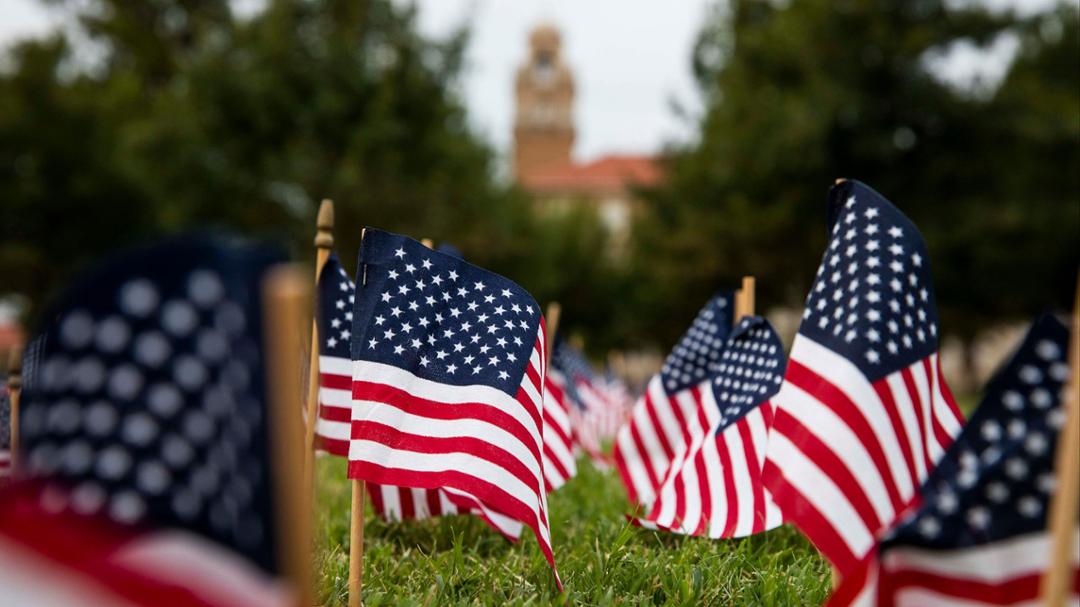The university’s wide-reaching war efforts changed the course of its history.
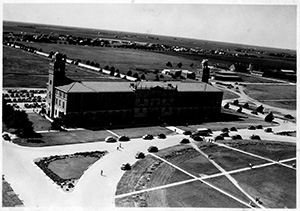
Editor's Note: This story was originally published in August 2015. Some updates have been made.
During World War II, the U.S. fought for its life. Unbeknownst to many, so did Texas Tech University.
In honor of the 80th anniversary of D-Day, we bring you the tale of how that generation's fighting spirit turned the tides for the university, and how the university, in turn, paid homage to its defenders.
Pre-war
“To understand what Texas Tech was like in the 1940s, you have to understand a little bit about the history of the school,” said Lynn Whitfield, university archivist in the Southwest Collection/Special Collections Library. “When Texas Tech opened its doors in the fall of 1925, the number of kids who showed up to enroll was much greater than anticipated.”
So much so, in fact, the university had no place to put its new students and faculty. With no dormitories built at that time, Texas Tech President Paul W. Horn asked Lubbock residents to open their homes to the newly enrolled 910 students.
“When the Texas Legislature funded Texas Tech, they gave the school enough to get started, but not really much more than that,” Whitfield said. “So Texas Tech's administration had to appeal to Texas Gov. Ma Ferguson on more than one occasion to keep the school running in its early years.”
The university built one men’s dormitory, now known as West Hall, and one women’s dormitory, now Doak Hall, which opened in 1934. But the situation wasn’t looking good.
“By the early 1930s, Texas Tech was in dire financial straits,” Whitfield said. “It had to lay off 17 faculty members, and Texas Tech cut faculty salaries by 5% when the Texas State Legislature cut the school’s funding by more than 27%. It wasn’t until 1937 that faculty salaries were restored, but even then, the school was in a financial situation.”
World War II at Texas Tech
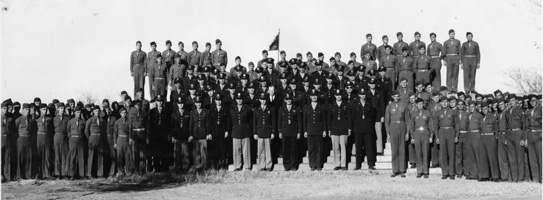
After the Japanese attack on Pearl Harbor on Dec. 7, 1941, pulled the U.S. into World War II, the Texas Tech Board of Directors took action to make the university more accessible to students in the military. In its first meeting of 1942, the Board voted to reduce by one-third the fees for correspondence courses to men in the military and to grant degrees to any student called into the armed services who had less than half a semester remaining until graduation, if that person’s work indicated he was entitled to a degree.
After years of fluctuating enrollments, the university’s student population took a dive after Pearl Harbor.
“Then we get to the 1942-1943 school year, and Texas Tech’s enrollment is the lowest it’s been since 1927,” Whitfield said. “They’re scrambling around, the war has started, and the students just aren't there. They’re leaving for the war; faculty are leaving for the war.”
According to a notation in the 1943 Board of Directors minutes, the loss in enrollment was not excessive when compared to the loss in enrollment in colleges and universities of the U.S. At the time, more than 2,500 former Texas Tech students were in the armed services.
With so many men leaving to fight, it was up to the women to keep the university afloat. Bettie Fagan shared what it was like to be a Texas Tech student during the war.
“There were no men around; it was just girls,” she said. “Everybody was doing what they could to help out. My mother used to say people who bought white bread were not standing behind the troops. We saved the white bread for them and we bought the brown bread, which was not the preferred bread then.”
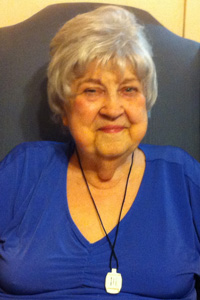
In 1941, the Association of Women Students called a meeting on campus to talk about how women could participate in the defense effort, Whitfield said. For the next four years, the group offered canning demonstrations and hosted a campus-wide donation drive. The women put on a home nursing course as well as courses from the Red Cross, such as the Red Cross Canteen Aid course. They also hosted defense bond drives.
“The division of home economics also was very instrumental,” Whitfield said. “The female students living in the Home Management House planted a victory garden here on campus, and it was very successful. It was covered in the campus newspaper about how little it cost to plant the garden and how much they were able to grow out of it. Then they did canning demonstrations out of that as well.”
But they weren’t just helping the campus community.
“The faculty of home economics went into the Lubbock community and helped people understand how to use ration books, how to make the rations they did have go further and different ways you could substitute things when you didn’t have them in order to make nourishing and healthy meals,” Whitfield said.
Texas Tech President Clifford B. Jones presented a report on the university’s 1943 war efforts to the Board of Directors. Among those efforts were the housing, feeding and training of 1,250 pre-flight students for the Air Corps, who arrived in February and March; the housing, feeding and training of 500 engineers receiving specialized training for the 8th Service Command; and the university’s newly established Senior Engineering ROTC and Signal Corps units.
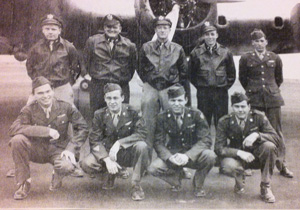
The university also helped the wives of the servicemen coming to Lubbock.
“At Lubbock Army Air Field, the barracks were pretty unpleasant,” Whitfield said. “So they invited the wives to come to campus and attend courses. They had home decoration courses; they had nutrition courses. They had charm school, where they taught the women good posture, social skills and how to dress. One of the ways they were able to draw military wives was offering daycare so the wives could drop off their children in the campus nursery for a few hours to attend classes.”
Because women were the university’s primary target for prospective new students during World War II, home economics faculty spoke on the radio.
“They went on KFYO and held a series of talks basically saying, ‘These are the types of programs we have for women,’ and it was specifically addressed to girls graduating high school with the idea that, ‘should they go to college,’” Whitfield said. “It was trying to encourage women to continue their education during this time.”
As the war continued, Texas Tech was already focused on how to help returning veterans. The Board of Directors granted Jones the authority to sign a contract with the Veterans Administration in Washington, D.C., for the instruction and vocational rehabilitation of disabled veterans.
Training at Texas Tech
The pre-flight program began after the military realized it didn’t have the resources available to train all the young men who wanted to be pilots. The Army reached out to civilian contractors to do initial flight training through the Civilian Pilot Training Program. Two Lubbock instructors, Clent Breedlove and M. F. Dagley, took up the challenge, said John McCullough, who did his history master’s thesis on the subject.
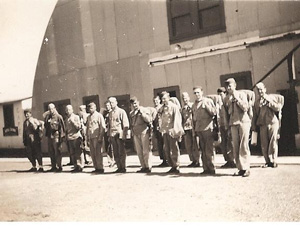
The pre-flight faculty provided the in-class portion of the training, which was held in classrooms on the Texas Tech campus. The two civilian instructors then provided 8 hours of in-flight training at Breedlove Airport on East 50th Street and Dagley Field near 34th Street and Quaker Avenue. The course of rigorous education, physical training and flight training for the cadets was designed to weed out anyone not capable of being a military pilot.
“The pre-flight students would go through this five-month training program,” McCullough said. “They would take classes in math, physics, history, English, civil aeronautics, meteorology and first aid. The military would put them through these courses and they would live in Sneed Hall and West Hall, but they were kept segregated from all the other students while on campus. They were told not to talk to the students or mix with them. I have seen photographs of the posts and chains that were set up all around West Hall and Sneed Hall with signs on them that read, ‘Posted military training site. No trespassing.’
“In fact, they would not even have the same passing period as other students on campus. The other students would change classes and then, when the grounds were clear, the pre-flight students would march together to class as a military group. Life in the military was very much regimented and they did everything together.”
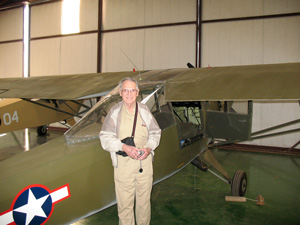
James Fagan arrived at Texas Tech as a pre-flight student in 1943.
“During our stay in Lubbock, from the fall of 1943 until the spring and summer of 1944, we marched up and down to the classrooms, everywhere we went,” he said. “We marched around the campus and where Jones AT&T Stadium is now was our marching area, exercise area and everything. Part of our exercise was to run along the railroad tracks, which are not there now, to the Brownfield intersection with the Levelland highway and back to the old stadium. None of it was paved.”
His wife Bettie added, “He thought this was the awfullest sandy place and he would never want to live here – until we met. I was going to Texas Tech so he changed his mind.”
During his pre-flight training, James Fagan lived on the second floor of West Hall. West Hall, and its neighbor Sneed Hall, had both been emptied to accommodate Fagan and his peers.
“When they brought the pre-flight students here, Texas Tech officials told the students who were living in West Hall and Sneed Hall that they would have to move out of their dormitories to make way for the pre-flights students,” McCullough said. “Since this was wartime, many sacrifices had to be made by the civilian population, too, and housing was in short supply. They were given very short notice. They made the announcement in the Lubbock Morning Avalanche on Feb. 27, 1943, and by March 2 or 3, the first officers and the initial men showed up to start the pre-flights program, and the next week after that, the first trainload of a few hundred of them showed up; and of course, they had to have some place to put them.
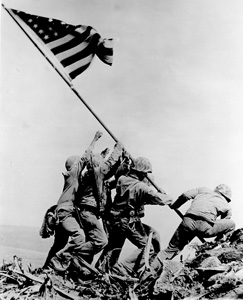
“The civilian students may have found housing somewhere else on the Texas Tech campus, but I think a lot of them had to find off-campus housing, such as apartments or at someone's house where a room was being rented,” he added. “I’m sure that the college helped with that.”
In the summer of 1944, the Army decided it had too many men training to become pilots so Fagan’s entire class was washed out of the program.
“Instead of graduating, we got on another troop train,” he said. “Two guys on the top bunk and two guys on the bottom bunk, and there was supposed to be one in each.”
Fagan was headed to Europe.
World War II in the Pacific
William R. Pasewark Sr., who later would become a business professor at Texas Tech, was 18 years old when a recruiter forced him into the Marines by commandeering his enlistment paperwork. It was 1943, and it wasn’t long before Pasewark found himself on the Hawaiian island of Maui, preparing to invade an island he'd never heard of: Iwo Jima.
“Iwo Jima was the most costly battle in Marine Corps history,” Pasewark said. “It was the only battle where we had more casualties than the enemy.”
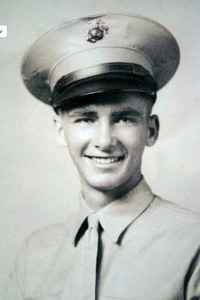
The invasion began on the morning of Feb. 19, 1945. Not in the first waves of the invasion, Pasewark remembers seeing injured Marines brought back to the ship. When it was his turn to go ashore, he quickly found the beach – instead of the sand they had practiced in – was made of volcanic ash that made it impossible to dig deep foxholes, the Marines’ first line of defense.
Japanese soldiers rained mortar shells down on them from a nearby ridge. An explosion near him damaged Pasewark’s hearing in one ear.
The four-week battle included some of the fiercest and bloodiest fighting in the Pacific theater, but the Americans were ultimately victorious. A photo of five Marines and a Navy corpsman raising the U.S. flag atop Mount Suribachi immortalized the battle.
Pasewark recalled in graphic detail carrying dead Marines down from the hills and throwing them in trucks. They would be buried at sea.
“In World War II, the battle in the Pacific was much different than the battle in Europe,” he said. “In Europe, the Germans surrendered. You never see a picture of the Japanese surrendering because they had a kamikaze suicide culture and they'd die for their emperor.”
Japanese surrender
After his return from Iwo Jima in April 1945, Pasewark trained for the next big invasion. “I was on Maui, living in a tent on the side of Mount Haleakala and we were preparing to invade Japan,” he said. “The atomic bomb went off in the beginning of August. The statements you see are that invasion would have cost 1 million casualties. And so, when we heard about the surrender, obviously we were happy.”
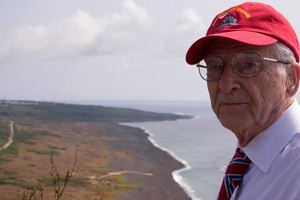
Fagan, who had worked as a B-17 tail gunner during the war in Europe, was back in the U.S. when he heard the news.
“We were ordered to go to El Paso,” he said. “We boarded a train and knew both the atomic bombs had dropped and Japan would probably surrender. We were on the train when we found the news of the Japanese surrender. El Paso is right across the border from Juarez, Mexico, where they had tequila. The guys pooled their money and several went over across the border – it was an open facility then. They bought up all the tequila they could find because they knew it was going to be a big celebration on the train before we got to Sioux Falls, South Dakota. Sioux Falls was our staging area. From there, we knew that we’d end up in the South Pacific war. We knew that before we left England because we named our plane ‘Double Trouble.’”
Pasewark said it’s easy for people looking back to question the use of the atomic bomb. Not so for the soldiers.
“Some armchair historians say, ‘Oh, should we have dropped the atomic bomb?’ But they weren’t out there at the time,” he said. “And nevertheless, that’s a personal thing, but the atomic bomb was going to be developed no matter what, so you might as well save a lot more casualties.”
Aftermath at Texas Tech
Throughout the war, Texas Tech had been holding on, despite its financial troubles. Enrollment dropped from 3,549 in fall 1941, to 2,860 in fall 1942 and bottomed out at 1,696 in fall 1943. After the German surrender in May 1945, enrollment for that fall was up to 2,443. And after the Japanese surrender in August 1945, the 1946 fall enrollment shot up to 5,366.
The Board of Directors negotiated a contract to accept servicemen under the Servicemen’s Readjustment Act of 1944. Commonly known as the GI Bill of Rights, the law provided free university tuition and living expenses for returning World War II veterans. The board also recommended abbreviated courses for veterans and established an office on campus to help veterans with their return to civilian life.
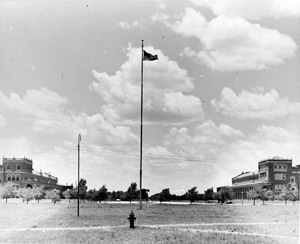
“The GI Bill of Rights actually helped turn things around,” Whitfield said. “When you get to 1945, suddenly Texas Tech enrollment is booming and that actually brings additional problems to the university. One of the problems is faculty.”
Many of the male faculty had left for the war and not returned. And to exacerbate the problem, the Texas Legislature passed a measure preventing husbands and wives from teaching together at state-supported institutions.
“You don’t have enough faculty, but now you’re saying women can’t teach there if their husbands are there,” Whitfield said. “So Texas Tech’s president, rather than having to fire six faculty women, granted them leaves of absence and waited for the incoming Legislature to reverse the measure on the grounds there weren’t enough qualified teaching faculty, and they needed to keep the wives on.”
Faculty numbers weren’t the only post-World War II issue. Even after the 1938 construction of the second men’s and women’s dormitories, Sneed and Drane halls, housing was a problem.
“The empty barracks at the Lubbock Army Air Field were not enough to accommodate the former soldiers and their wives,” Whitfield said. “So on campus, they moved the women from Women’s Dormitory 1 and they put them three to a room in Women’s Dormitory 2. If you've ever been in those rooms, they’re tiny. So three, dog-piled in a room, was kind of tough.”
The university also built four new dormitories and added 32 war surplus buildings by 1947.
“Basically, if you look at the history of Texas Tech,” Whitfield said, “in the 1920s, we’re new, we’re trying to make ends meet. In the 1930s, we’re starting to go under. By 1947, with all the military activity on campus, suddenly we are in a reversal of fortune. By 1948, we are now in the black; Texas Tech is actually doing well. So when you think about the war years, I think all the GIs and the families coming to Lubbock and Texas Tech are actually what saved Texas Tech from going under. That’s an important part of our history to remember.”
Memorial Circle
That’s exactly what happened.
Since the school’s founding, a large round area of grass was saved in front of the Administration building, called only “the circle.” In February 1948, the Board of Directors voted to approve its new name, Memorial Circle, and the expenditure of more than $5,400 for sidewalks.
“People were not supposed to walk on the grass,” said Amy Mire, executive associate in the Office of Research & Innovation and former assistant to the university archivist in the Southwest Collection. “They could be fined 25 cents.”
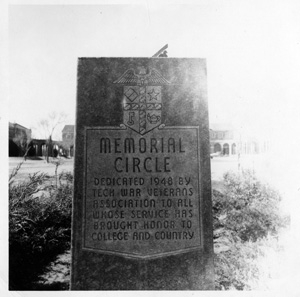
On May 2, 1948, Texas Tech hosted an elaborate dedication ceremony for Memorial Circle. According to that morning’s Lubbock Avalanche-Journal, hundreds of visitors were expected to attend the event, featuring the Texas Tech concert band, the all-male chorus, the Texas Tech ROTC and speeches from campus administrators. Major Gen. Andrew D. Bruce, commander of the 4th Army at Fort Sam Houston and a decorated veteran of both world wars, gave an address on national security.
And most importantly, a 40-inch red granite monument was dedicated, which reads: “Memorial Circle: Dedicated 1948 by Tech War Veterans Association to all whose service has brought honor to college and country.”
As the Avalanche-Journal points out, “The dedication applies not only to those in the past but to those who shall perform such a service in the future as well.”
The Tech War Veterans Association (TWVA) was organized May 1, 1944 with a membership of nine men, according to the 1948 La Ventana yearbook, and was open to Texas Tech students who had been honorably discharged from the armed services. In its constitution, adopted June 12, 1944, the group pledged to “uphold and fight for the ideals in which our forefathers believed,” to strive for continued improvement so other returning veterans would find Texas Tech “a more democratic and stronger student association for which they fought” and to “give aid in all possible ways to our brother veterans.”
About 60 veterans joined the group for the fall of 1944, according to the 1945 La Ventana. By the 1946 yearbook, the organization had about 300 active members. In 1947, the yearbook listed group involvement in campus traffic improvement, completion of the museum, a nursery, Blue Cross Hospital service and a Veterans’ Memorial Loan Fund, among other programs. It carried the notation: “There is no doubt that the TWVA is one of the most influential organizations on campus and that it is a credit to the veterans and an aid to both veteran and non-veteran students.”
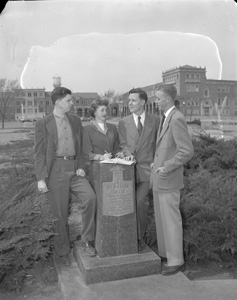
Among the group’s achievements listed in the 1948 yearbook were the naming of Memorial Circle and the monument dedication. But the number of World War II veterans in college was on the decline. In the 1949 yearbook, 60 men listed their participation in TWVA. By 1952, only one person listed his participation.
The last man to mention his membership in a yearbook was Roy Thomas Grimes, who would become a longtime educator and Lubbock Independent School District trustee before his death in 2014. Other notable names from the group include Curtis Sterling, owner and publisher of the Brownfield News who died in 2004; Clint Formby, who was involved in radio stations throughout Texas and aired his “Day-by-Day Philosopher” segment for nearly 55 years until his death in 2010; and James Denton, an associate justice for the Texas Supreme Court until his death in 1982.
Hardly anything else is known about the Tech War Veterans Association.
“I haven’t run across the group anywhere else,” Whitfield said. “I'’ve been looking for that as I’ve gone through and done the digital files, and it’s very strange that that particular aspect is not as well documented.”
Little is known about the creation of the monument, either. The Lamb County Leader from Dec. 25, 1947, mentions the Memorial Circle name was suggested by the TWVA, which was “laying plans for securing a suitable plaque and arranging a public ceremony when the formal dedication will be made.” But Whitfield said she believes Memorial Circle was designated for the veterans memorial because of its location.
“If you looked at Texas Tech like a body, Memorial Circle would be its heart,” she said. “Memorial Circle is placed on an axis up through the central part of Texas Tech in what is now known as the historic district. The early buildings of the campus are sort of arranged around there. A lot of the military science displays, the marches, were taking place around Memorial Circle and the engineering key. It was a very visible spot, and I think part of the reason the flag poles were placed in Memorial Circle was because of where the military moved around on the campus.”
After the war
At the time of the Japanese surrender, Fagan still had several months of his two-and-a-half year commitment to serve before being discharged, so the Army put him to work as a counselor because of his college experience.
“I counseled all of the soldiers in all branches who were being discharged,” he said. “I looked at what they did in the military, whether they were a mechanic or a cook or whatever, and then I looked in a great big book and helped them try to decide what they would like to do in civilian life. I pointed out the advantages to the college education money that was available. I pointed out they had six months they could loaf and get paid. Some of them did it, I never did.”
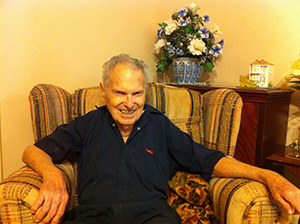
When he was discharged, he returned to his fiancée in Lubbock and attended Texas Tech as a civilian.
“We were engaged that whole time,” Bettie Fagan recalled. “He didn’t want to marry before the war and I guess I did. He didn’t want to die and leave me a widow, and he didn’t know if he was coming back or not, so it was a really sad time. We didn’t marry until after the war.”
James earned a degree in electrical engineering, which he used in his later jobs at Reese Air Force Base, the city of Lubbock and at Motorola’s first Lubbock service center.
Looking back in 2015, the two agreed on the perspective.
“It feels like I’m in sort of another world,” James said.
“That’s how I feel: I’ve lived a second lifetime,” Bettie added. “I think all that was another lifetime ago.”
James and Bettie Fagan both passed away in 2018.
William Pasewark said he never needed closure after the war, even after what he’d seen on Iwo Jima. “After World War II, for 50 years, until 1995, I doubt that I – and almost all other men – talked about their battle experience or their service,” he said. “People ask, ‘Why does that happen, that you never talked about it?’ I think there were several reasons. One reason was your experience was just one among 16 million.
“The second thing is, I found out: How do you become an officer? Because you have a college education. We had the GI Bill of Rights. I got my bachelor’s degree and almost got my master’s but went on to get a doctorate on the GI Bill of Rights. When you get a bachelor’s degree in three years instead of four, you don’t have time to talk about war experiences. That was the past and I always looked toward the future, so there was nothing to recover from.”
Pasewark went on to teach business, coming to Texas Tech in 1956. He taught in the College of Business, now the Jerry S. Rawls College of Business, until 1982, when he retired to focus on writing business and computer textbooks. He authored or co-authored 94 textbooks before his death in 2021.
70 years later
Seven decades after the battle that claimed his hearing, Pasewark went back on Iwo Jima in 2015.
“It was stimulating and very sentimental,” he said. “We went to the top of Mount Suribachi where the flag was raised and where the Japanese had sent down mortars on the beaches where we landed. So, I saw what happened all those years ago, on those beaches, and I could see how difficult it was, especially for the Marines in the first waves. And I saw where I was when mortars hit very close.”
The 70th anniversary of the battle was marked by a ceremony on Iwo Jima that brought together American and Japanese veterans, family and dignitaries.
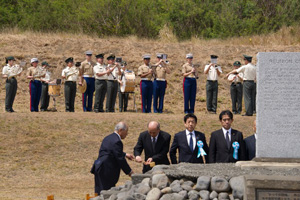
“This is a Japanese soldier who survived Iwo Jima,” Pasewark indicated in a photograph. “Very few surrendered. There were 23,000 Japanese on Iwo Jima. You see the figure of 216 surrendered. I only saw two or three of them.”
Despite the ferocity of the war he experienced firsthand, Pasewark said he – unlike some in his generation – does not hate the Japanese.
“People react differently to battle and enemies who want to kill you,” he said. “I was so fortunate for many reasons, but I got occupied with other things after the war. I fought on Iwo Jima, but I was not in the first waves that went in and I did not have a hatred for the Japanese because they were caught up in a culture where Hirohito, their emperor, was considered divine, a god. That’s hard for us to believe nowadays but that’s what they believed.”
Pasewark emphasized the U.S. did not claim its enemies’ land after the war.
“And people don’t always understand that we gave Iwo Jima back to the Japanese,” he said. “We gave Okinawa back to the Japanese. We did not keep land we conquered in Europe. We gave away the Panama Canal. American citizens don’t understand or don’t appreciate our heritage, our history. And as the saying goes, unless you understand your history, you repeat it and make the same mistakes.”

